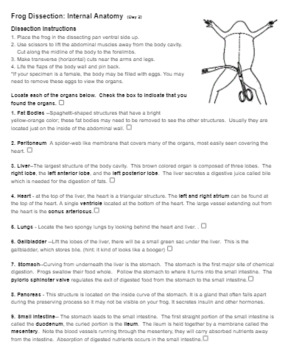


Cut along the midline of the body to the forelimbs. Use scissors to lift the abdominal muscles away from the body cavity.Place the frog in the dissecting pan ventral side up.Label each of the structures underlined above. On the roof of the mouth, you will find the two tiny openings of the nostrils, if you put your probe into those openings, you will find they exit on the outside of the frog.ħ. Run you finger over both sets of teeth and note the differences between them.Ħ. Both are used for holding prey, frogs swallow their meals whole and do NOT chew. The maxillary teeth are found around the edge of the mouth. The vomerine teeth are found on the roof of the mouth. Use your probe to open the glottis and compare that opening to the esophagus.ĥ. The frog breathes and vocalizes with the glottis. This slit is the glottis, and it is the opening to the lungs. (You may need to use your probe to get it to open up). Just behind the tongue, and before you reach the esophagus is a slit like opening. To what structure does the Eustachian tube attach? _Ĥ. They are used to equalize pressure in the inner ear while the frog is swimming. Close to the angles of the jaw are two openings, one on each side. Use a probe to poke into the esophagus.ģ. In the center of the mouth, toward the back is a single round opening, the esophagus. Draw a sketch of the tongue, paying attention to its shape.Ģ. Does it attach to the front or the back of the mouth? _ (You may remove the tongue). Cut deeply so that the frog's mouth opens wide enough to view the structures inside.ġ. Pry the frog's mouth open and use scissors to cut the angles of the frog's jaws open. Measure the diameter (distance across the circle) of the tympanic membrane. The tympanic membrane is used for hearing. Just behind the eyes on the frog's head is a circular structure called the tympanic membrane. What color is the nictitating membrane? _ What color is the eyeball? _Ħ. Use tweezers to carefully remove the nictitating membrane. Locate the frog's eyes, the nictitating membrane is a clear membrane that attached to the bottom of the eye. Compare the length of your frog to other frogsĥ. Use a ruler to measure your from the tip of the head to the end of the frog's backbone. How many toes are present? _Are the toes webbed? _Ĥ. How many toes are present on each foot? _ Are they webbed? _ģ. Dorsal side color _ Ventral side color _Ģ. Observe the dorsal and ventral sides of the frog.


 0 kommentar(er)
0 kommentar(er)
